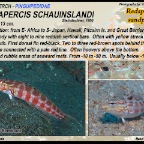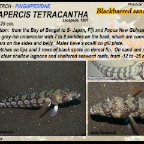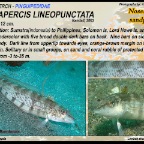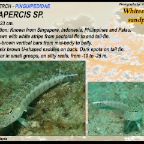Sandperch - Pinguipedidae
SANDPERCHES - PINGUIPEDIDAE
These well-spread and camouflaged bottom-dwellers are mostly observed in lagoons and outer reefs. Some like to inhabit areas with sand and coral rubble, while others prefer rock or coral to live on. Every day they lay down their cigar-shaped body on a strategic spot, and wait motionless for prey to pass. Standing on their pectoral fins with the head high, they are able to keep an eye on their surroundings. Sandperches feed on small fish and benthic invertebrates. They live alone but are often observed living in pairs. Only with some of the Pinguipedidae family is it possible to directly determine the sex of the specimen. The males have a territory from around twenty square meters and a harem with two to five females which they protect from family members. Reproduction starts just before sunset when the male positions himself next to the female and starts head-banging for a while. A bit later the male lays his head on the female and starts waving towards her with his pectoral fins. The moment the sun goes down, they both swim up around a meter and spawn. The fertilized eggs then will float in the direction of the open water. The larvae will have to survive as pelagic zooplankton for one to two months before they will start a life among a coral reef. All juveniles are born females and can change sex from a certain age. Length: 23 cm.Distribution: from E- Africa to Sulawesi (Indonesia), Papua New Guinea and Fiji.Pale grey-brown with 9 to 10 brownish bars on lower body, white lateral line from headto tail fin. White margined orange spot on pectoral fin base. Speckled back and snout, white vertical lines on cheek. Balinese version with red bars and without white line. Solitary or in small groups, sand and rubble bottoms of coastal reefs, from -2 to -20 m Length: 25 cm. Distribution: from the Bay of Bengal to S- Japan, Fiji and Papua New Guinea.White to grey-ish undercolor with 7 to 8 saddles on the back, which are connected toto the bars on the sides and belly. Males have a ocelli on gill plate. Dark blotches on lips and 3 rows of black spots on dorsal fin. On sand and rubble areas of clear shallow lagoons and sheltered seaward reefs, from -12 to -25 m. Length: 23 cm.Distribution: known from Singapore, Indonesia, Philippines and Palau.Grey-brown with white stripe from pectoral fin to end tail-fin. Ten pale-brown vertical bars from mid-body to belly. Around six brown U-shaped saddles on back. Dark spots on tail fin. Solitary or in small groups, on silty reefs, from -10 to -25 m. Length: 11 cm.Distribution: Andaman Sea to S- Japan, Indonesia, Papua New Guinea and G.B.R.White-pinkish body colour with 5 red-brown saddles on back. 8 to 9 pale bars on sidesand belly. First dorsal fin black, dark margin on tail fin and yellow spot on base of pectoral fin. Red spots on second dorsal fin and tail fin. Yellow areas on sides andpale blue lines near the eyes. On sand and rubble areas near reefs, from -10 to -40 m.Length: 13 cm.Distribution: from E- Africa to S- Japan, Hawaii, Pitcairn Is. and Great Barrier Reef.White body with eight to nine reddish vertical bars. Often with yellow streak on snoutand mouth. First dorsal fin red-black. Two to three red-brown spots behind the eyes,these are connected with a pale red line. Often hoovers above the bottom.Sand and rubble areas of seaward reefs. From -10 to -50 m. Usually below -16 m Length: 26 cm. Distribution: from the Red Sea to Fiji, Black blotch on tailfin, males have lines on the cheek. Territorial and haremic, feeds on small invertebrates and fishes. In shallow lagoons and protected seaward reefs from -2 to -26 m, on sand and rubble.Solitary or in small groups. Length: 18 cm.Distribution: Mauritius & Maldives to S.W- Japan, Pitcairn Is. and Great Barrier Reef.White to grey undercolour with a brownish blotched pattern on the back and sides.Row of blackish dash-spots from underneath pectoral fin towards tail-base. Whitestreak on tail-fin and white base at pelvic fins. Brown to orange blotches on foreheadand snouth. Males with black ocellus behind head. From - 3 to -50 m. Length: 12 cm.Distribution: Sumatra(Indonesia) to Philippines, Solomon Is, Lord Howe Is. and G.B.R.White undercolor with five broad double dark bars on back. Nine bars on sides and lower body. Dark line from upperlip towards eyes, orange-brown margin on first dorsal fin. Solitary or in small groups, on sand and coral rubble of protected coastalreefs, from -3 to-35 m. Length: 23 cm.Distribution: from the Gulf of Thailand to S- Japan, Marshall Is, Fiji and Australia.White body colour with eight brown bars on the side and back.Vertical line underneath the eye. Common in seagrass beds.Sand and rubble areas from lagoons and bays, from -1 to -20 m. Length: 17,5 cm.Distribution: Andaman Sea to SW- Japan, Phoenix Is., Samoa and Australia.Greyish with darker blotches on back, pale sides with dashed-line on lower body.Yellow-orange lower lip, white stripe in tail fin. Males have ocellus in neck.Solitary or in small groups, on sand, rubble or rock. Not shy.Lagoons and seaward reefs, from -3 to -50 m.






















